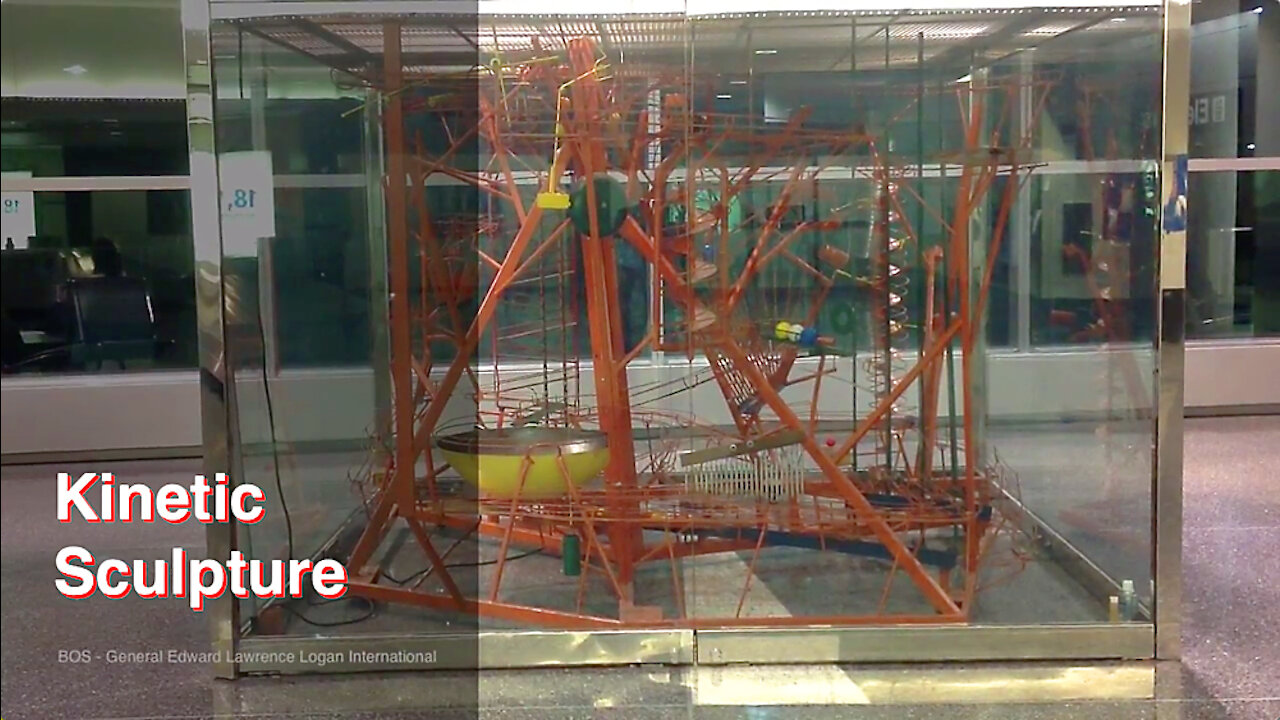Premium Only Content

Kinetic Sculpture At Logan Airport
This is a Kinetic Sculpture art exhibit I came across at the Logan Airport in Boston, MA. It is titled "Exercise in Frugality" by artist George Rhoads, 1986.
Wikipedia:
In physics, the kinetic energy (KE) of an object is the energy that it possesses due to its motion.[1] It is defined as the work needed to accelerate a body of a given mass from rest to its stated velocity. Having gained this energy during its acceleration, the body maintains this kinetic energy unless its speed changes. The same amount of work is done by the body when decelerating from its current speed to a state of rest.
In classical mechanics, the kinetic energy of a non-rotating object of mass m traveling at a speed v is {\displaystyle {\begin{smallmatrix}{\frac {1}{2}}mv^{2}\end{smallmatrix}}}{\begin{smallmatrix}{\frac {1}{2}}mv^{2}\end{smallmatrix}}. In relativistic mechanics, this is a good approximation only when v is much less than the speed of light.
The standard unit of kinetic energy is the joule, while the imperial unit of kinetic energy is the foot-pound.
The adjective kinetic has its roots in the Greek word κίνησις kinesis, meaning "motion". The dichotomy between kinetic energy and potential energy can be traced back to Aristotle's concepts of actuality and potentiality.[2]
The principle in classical mechanics that E ∝ mv2 was first developed by Gottfried Leibniz and Johann Bernoulli, who described kinetic energy as the living force, vis viva. Willem 's Gravesande of the Netherlands provided experimental evidence of this relationship. By dropping weights from different heights into a block of clay, Willem 's Gravesande determined that their penetration depth was proportional to the square of their impact speed. Émilie du Châtelet recognized the implications of the experiment and published an explanation.[3]
The terms kinetic energy and work in their present scientific meanings date back to the mid-19th century. Early understandings of these ideas can be attributed to Gaspard-Gustave Coriolis, who in 1829 published the paper titled Du Calcul de l'Effet des Machines outlining the mathematics of kinetic energy. William Thomson, later Lord Kelvin, is given the credit for coining the term "kinetic energy" c. 1849–51.
Energy occurs in many forms, including chemical energy, thermal energy, electromagnetic radiation, gravitational energy, electric energy, elastic energy, nuclear energy, and rest energy. These can be categorized in two main classes: potential energy and kinetic energy. Kinetic energy is the movement energy of an object. Kinetic energy can be transferred between objects and transformed into other kinds of energy.[6]
Kinetic energy may be best understood by examples that demonstrate how it is transformed to and from other forms of energy. For example, a cyclist uses chemical energy provided by food to accelerate a bicycle to a chosen speed. On a level surface, this speed can be maintained without further work, except to overcome air resistance and friction. The chemical energy has been converted into kinetic energy, the energy of motion, but the process is not completely efficient and produces heat within the cyclist.
The kinetic energy in the moving cyclist and the bicycle can be converted to other forms. For example, the cyclist could encounter a hill just high enough to coast up, so that the bicycle comes to a complete halt at the top. The kinetic energy has now largely been converted to gravitational potential energy that can be released by freewheeling down the other side of the hill. Since the bicycle lost some of its energy to friction, it never regains all of its speed without additional pedaling. The energy is not destroyed; it has only been converted to another form by friction. Alternatively, the cyclist could connect a dynamo to one of the wheels and generate some electrical energy on the descent. The bicycle would be traveling slower at the bottom of the hill than without the generator because some of the energy has been diverted into electrical energy. Another possibility would be for the cyclist to apply the brakes, in which case the kinetic energy would be dissipated through friction as heat.
Like any physical quantity that is a function of velocity, the kinetic energy of an object depends on the relationship between the object and the observer's frame of reference. Thus, the kinetic energy of an object is not invariant.
Spacecraft use chemical energy to launch and gain considerable kinetic energy to reach orbital velocity. In an entirely circular orbit, this kinetic energy remains constant because there is almost no friction in near-earth space. However, it becomes apparent at re-entry when some of the kinetic energy is converted to heat. If the orbit is elliptical or hyperbolic, then throughout the orbit kinetic and potential energy are exchanged; kinetic energy is greatest and potential energy lowest at closest approach to the earth or other massive body, while potential energy is greatest and kinetic energy the lowest at maximum distance. Without loss or gain, however, the sum of the kinetic and potential energy remains constant.
Kinetic energy can be passed from one object to another. In the game of billiards, the player imposes kinetic energy on the cue ball by striking it with the cue stick. If the cue ball collides with another ball, it slows down dramatically, and the ball it hit accelerates its speed as the kinetic energy is passed on to it. Collisions in billiards are effectively elastic collisions, in which kinetic energy is preserved. In inelastic collisions, kinetic energy is dissipated in various forms of energy, such as heat, sound, binding energy (breaking bound structures).
Flywheels have been developed as a method of energy storage. This illustrates that kinetic energy is also stored in rotational motion.
Several mathematical descriptions of kinetic energy exist that describe it in the appropriate physical situation. For objects and processes in common human experience, the formula ½mv² given by Newtonian (classical) mechanics is suitable. However, if the speed of the object is comparable to the speed of light, relativistic effects become significant and the relativistic formula is used. If the object is on the atomic or sub-atomic scale, quantum mechanical effects are significant, and a quantum mechanical model must be employed.
-
 0:48
0:48
lemmingking
4 years ago $0.01 earnedSculpture update 1
270 -
 0:22
0:22
SimmoJA
4 years agoChangi Airport
402 -
 0:15
0:15
KingsRansom
4 years agoAirport Road, Arizona
176 -
 0:19
0:19
memoabboud
4 years ago $0.08 earnedFrankfurt Airport
237 -
 0:17
0:17
RA378
4 years ago $0.01 earnedToronto airport landing
1641 -
 0:46
0:46
VideoCreation
4 years agoKinetic typography animated video
49 -
 1:11
1:11
Damore
4 years ago $0.01 earnedAirport Landing
107 -
 0:52
0:52
Angeline
4 years agoTrees Autumn Airport
18 -
 2:18
2:18
sunstarr
4 years agoMeet Logan
144 -
 0:28
0:28
KIVI
4 years agoBoise Airport Flights
85